Are you a night owl with a love for the dramatic? This article is waiting for you! Cultivate a hauntingly beautiful garden with these 15 captivating “black” flowers.
What are “gothic flowers” ? You’re absolutely right! On social media, these dark-hued beauties are often called “gothic flowers.” And that question about truly black flowers definitely pops up a lot. This trend celebrates blooms that appear black in certain lighting or have deep, velvety colors that evoke a sense of drama and intrigue.
Not Quite Black, But Bewitching All the Same
While there are no truly black flowers in nature (the darkest varieties tend to be very deep reds or purples), these gothic beauties hold a certain allure that brighter flowers can’t match. They exude a touch of dark magic, perfect for creating a hauntingly beautiful atmosphere.
1. Black Columbine
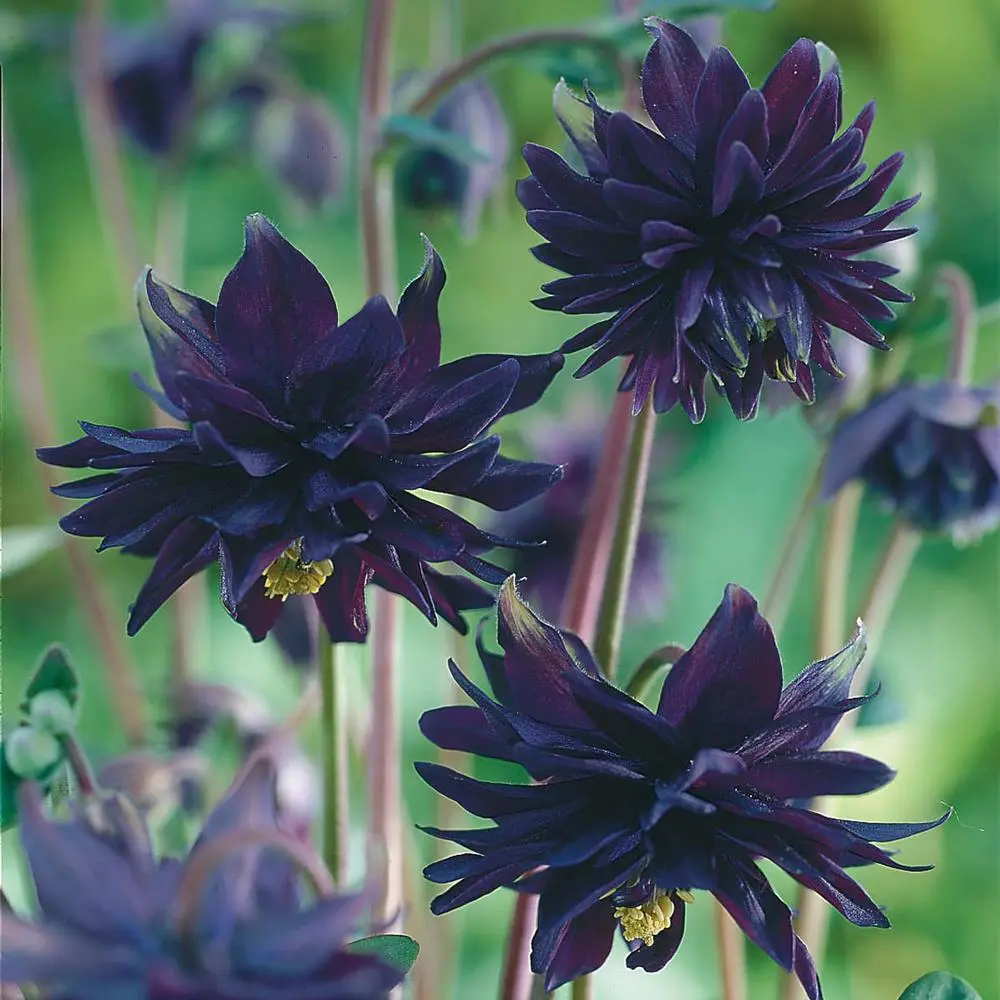
The Black Columbine, more accurately called Black Barlow Columbine (Aquilegia vulgaris var. stellata ‘Black Barlow’), isn’t truly black, but it comes pretty darn close! This stunning flower cultivar is a favorite among gardeners for its dramatic, almost-black blooms.
Here are some key characteristics of Black Barlow Columbine:
- Color: Deep purple, so dark it appears black in many lighting conditions.
- Bloom: Double flowered, with a full, rounded shape.
- Bloom Time: Late spring to early summer.
- Height: 24-36 inches tall.
- Light: Prefers full sun to part shade.
- Habit: Clump-forming perennial.
- Deer resistant: A bonus for many gardeners!
Black Barlow Columbine is a relatively easy flower to grow and makes a beautiful addition to flower beds, borders, or cottage gardens. It also attracts butterflies and hummingbirds, making it a great choice for a pollinator-friendly garden.
2. Black Coral Pea

The Black Coral Pea, also known as Kennedia nigricans, is a stunning vining or climbing plant native to Western Australia. It’s prized for its unique black and yellow flowers that bloom in spring and summer.
Here are some key characteristics of Black Coral Pea:
- Flowers: Black and yellow pea-like flowers, with the black appearing more prominent.
- Bloom Time: Spring and Summer
- Habit: Vigorous climber or trailing shrub
- Height: Up to 4 meters (13 feet) tall
- Spread: Up to 6 meters (20 feet) wide
- Leaves: Dark green, trifoliate leaves
- Light: Prefers full sun to part shade
- Soil: Adaptable to most well-drained soils, including light, sandy soils and heavier clay soils
- Water: Needs moderate watering, especially during hot weather. Drought tolerant once established.
- Frost tolerance: Moderately frost tolerant.
Black Coral Pea is a fast-growing plant that can quickly cover a fence, trellis, or other support structure. It’s also a good groundcover plant, especially in areas with poor soil. This plant attracts birds and butterflies to your garden.
3. Black Dahlia

While there are no true black flowers, some dahlia varieties come close with incredibly deep, velvety maroon or red blooms that appear almost black under certain lighting conditions. These “black” dahlias are a favorite among gardeners for their dramatic and mysterious beauty.
Here are some popular varieties of dahlia with near-black blooms:
- Black Satin Dahlia: This dahlia variety produces beautiful, deep red, chocolate-colored blooms that appear almost black. It’s a prolific bloomer with a compact to medium height, making it ideal for borders or containers.
- Black Jack Dahlia: This dahlia boasts large, velvety blooms in a very dark burgundy color that appears black in certain light. It’s a stunning focal point in any garden and attracts a lot of attention.
- Dark Bishop Dahlia: Another dramatic dahlia variety with near-black blooms. The Dark Bishop dahlia has dark, reddish-black, single blooms with a contrasting yellow center.
Growing Tips for Black Dahlias
Dahlias are relatively easy to grow from tubers, but they do require some specific care:
- Planting: Plant dahlia tubers in late spring or early summer after the danger of frost has passed.
- Light: Dahlias need at least 6-8 hours of sunlight per day.
- Soil: Plant dahlias in well-draining, fertile soil.
- Watering: Water dahlias regularly, especially during hot weather. However, avoid overwatering, as this can lead to rot.
- Staking: Taller dahlia varieties may need staking to support their large blooms.
5. Black Hellebore
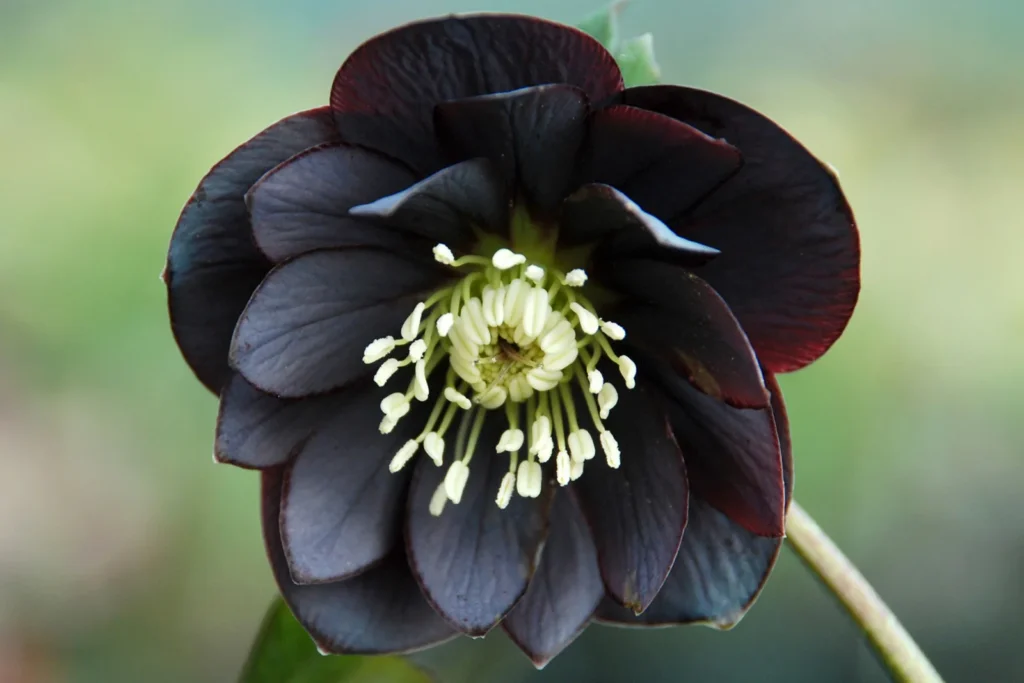
The term “Black Hellebore” can be a bit misleading. There are no true black flowers in the Hellebore genus, but there are some beautiful varieties with very deep, almost-black blooms!
Here’s the thing about Hellebores often called “black”:
- True Color: The classic Hellebore species, Helleborus niger (Christmas Rose), has white flowers occasionally tinged with pink. However, some Hellebore hybrids boast incredibly rich purples that appear black in certain lighting or from a distance.
- Hybrid Power: These “black” Hellebores are results of hybridization, often falling under the Helleborus orientalis category or more commonly referred to as Helleborus x hybridus. Breeders have created a stunning range of colors for these winter bloomers, including near-black shades.
Here are some popular “black” Hellebore varieties:
- Helleborus ‘Black Diamond’
- Helleborus ‘Dark and Handsome’
- Helleborus ‘Onyx Odyssey’
Growing Tips for Hellebores:
These winter bloomers are known for their low-maintenance nature:
- Planting: Plant Hellebores in fall or early spring in a shaded location with well-drained soil.
- Light: Hellebores prefer shade or dappled sunlight.
- Soil: They thrive in rich, moist, but well-drained soil.
- Watering: Water regularly, especially during the first growing season, but avoid overwatering.
- Maintenance: Deadhead spent flowers in late spring to encourage new growth.
6. Black Hyacinth
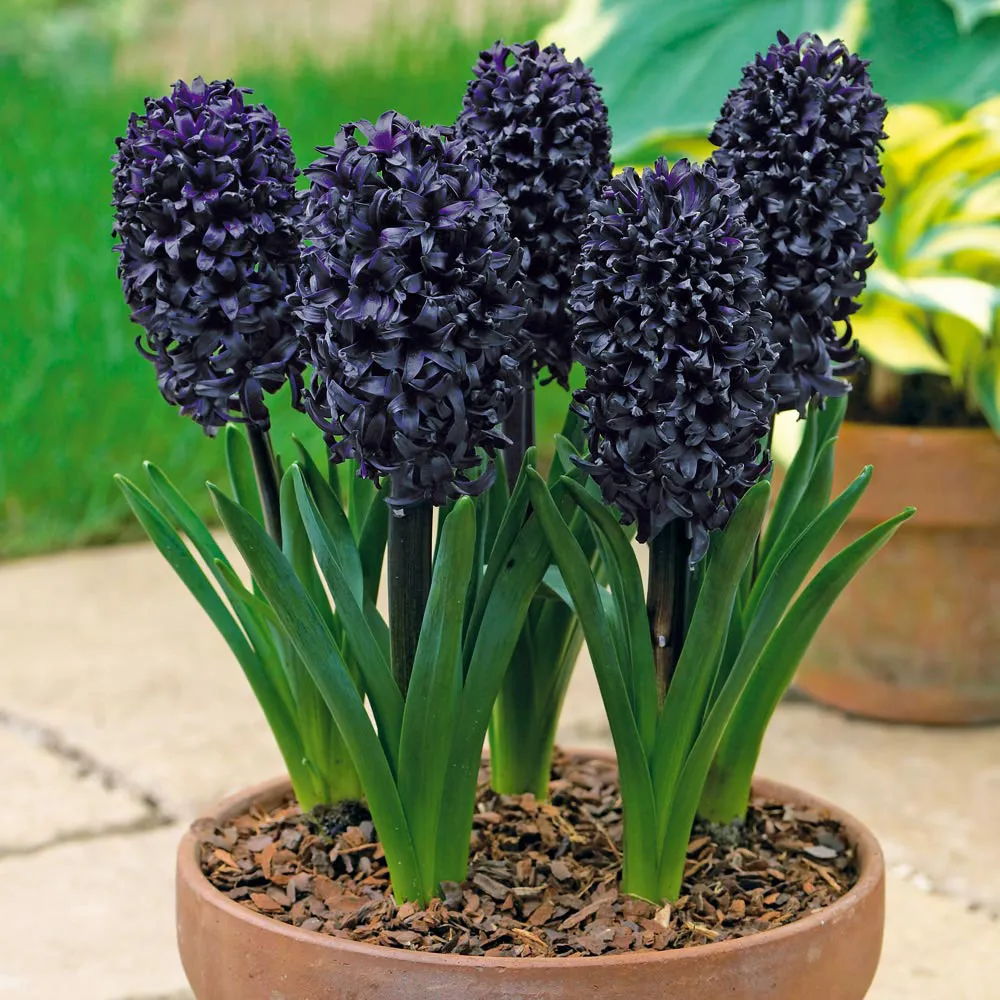
The thrill of “black” flowers extends to hyacinths as well! While there isn’t a true jet-black hyacinth variety, there are some cultivars that come incredibly close. These hyacinths boast blooms in such deep purples they appear black, especially in certain lighting conditions.
The Darkest of the Dark:
- Hyacinth ‘Dark Dimension’: This champion holds the title of the darkest hyacinth cultivar available. It produces near-black, violet-purple flowers with a dark stem, creating a dramatic contrast against its deep green foliage.
A Note on Midnight Mystic:
- Hyacinth ‘Midnight Mystic’: This variety was once hailed as the first truly black hyacinth, but it actually blooms a deep purple, especially when forced indoors. However, grown outdoors in cooler temperatures, it can achieve a darker, near-black color.
Growing Tips for Black Hyacinths:
Planting hyacinths is a great way to enjoy their intoxicating fragrance and dark blooms in the early spring. Here’s a quick guide:
- Planting: Plant hyacinth bulbs in fall, well before the ground freezes.
- Light: Hyacinths prefer full sun to partial shade.
- Soil: Plant them in well-drained soil with good organic matter.
- Watering: Water regularly during the growing season, but avoid overwatering.
- Winter Protection: In colder climates, mulch the planting area with straw or leaves to protect the bulbs from harsh winter temperatures.
7. Black Bearded Iris

The allure of the gothic garden extends to irises too! While there isn’t a perfectly black bloom in the iris world, there are some bearded iris cultivars that come remarkably close. These beauties boast near-black falls (the downward-facing petals) that create a dramatic and mysterious look.
Black Iris Champions:
- Black Satin Iris: This popular variety lives up to its name with velvety, deep-black purple falls and lighter standards (upward-facing petals) that can range from blue-purple to almost black depending on the light.
- Black is Black Iris: Another favorite, this iris features near-black falls with a slight blue hue and contrasting lighter purple standards.
- Black Taffeta Iris: This dramatic iris boasts almost black falls with a subtle sheen, like black taffeta fabric, and lighter standards in a deep, velvety purple.
Growing Tips for Black Bearded Iris:
Bearded irises are known for their ease of care and stunning blooms. Here’s how to cultivate these gothic beauties in your garden:
- Planting: Plant bearded iris rhizomes (underground stems) in fall, allowing enough time for them to establish roots before winter.
- Light: Bearded irises need at least 6-8 hours of sunlight per day.
- Soil: Plant them in well-drained soil with good air circulation. Amend the soil with compost or other organic matter if needed.
- Watering: Water regularly during the growing season, especially during dry periods. However, avoid overwatering, as irises don’t like soggy soil.
- Dividing: Every 3-4 years, you can divide bearded irises to maintain their vigor and flower production.
8. Black Bat Flower

Ah, the Black Bat Flower! This fascinating plant, with the scientific name Tacca chantrieri, truly lives up to its gothic nickname. Unlike some “black” flowers that are simply very deep purples or maroons, the Black Bat Flower boasts unique features that create a striking resemblance to a bat.
Unveiling the Black Bat Flower’s Secrets:
- The Dramatic Duo: The key players in the bat illusion are the large, modified leaves (bracts) flanking the actual flower. These bracts are typically a deep, dusky purple or maroon, often appearing black in certain lighting.
- Whisker Wonders: Adding to the bat-like charm are long, thread-like appendages called bracteoles that dangle beneath the bracts. These resemble a bat’s whiskers, making the illusion even more convincing.
- The Shy Flower: The actual flower of the Black Bat Flower is quite small and inconspicuous, usually a creamy white or light yellow. It nestles between the dramatic bracts, playing a supporting role in the overall bat costume.
Beyond the Look: Facts and Care Tips
- Origin Story: The Black Bat Flower is a native of Southeast Asia, thriving in the warm, humid conditions of tropical rainforests.
- Not a Fan of Frost: Due to its tropical origins, the Black Bat Flower is not frost-tolerant. It’s best suited for warm climates or grown as a container plant that can be brought indoors during cold weather.
- Light Preference: In its natural habitat, the Black Bat Flower grows on the forest floor, receiving dappled sunlight. Replicate this environment by providing partial shade or filtered light when grown in pots.
- Moisture Matters: This plant enjoys consistent moisture but doesn’t like soggy soil. Water regularly, allowing the top inch of soil to dry slightly between waterings.
- A Feast for the Eyes: The Black Bat Flower typically blooms throughout the late spring and summer months, offering an unforgettable visual treat.
A Gothic Gem for Your Garden
With its captivating appearance and intriguing characteristics, the Black Bat Flower is a sure conversation starter in any garden. If you’re looking for a unique and dramatic addition to your collection, especially one that embraces the gothic theme, the Black Bat Flower might be the perfect choice for you!
9. Black Bachelor’s Buttons

There isn’t a true black Bachelor’s Button variety, but there are some cultivars that come incredibly close! These beauties boast blooms in such a deep, rich purple or burgundy that they appear black, especially from a distance or in certain lighting conditions.
Here’s what you need to know about “black” Bachelor’s Buttons:
- A Touch of Mystery: The most popular “black” Bachelor’s Button variety is called Black Ball. It produces stunning, double thistle-like flowers in a deep crimson-black color.
- Not Quite Black, But Bewitching All the Same: These “black” Bachelor’s Buttons aren’t jet black, but they offer a rich, dramatic color that adds a touch of gothic charm to any garden.
- Long Bloom Time: These beauties are known for their long bloom time, typically flowering from late spring to early summer and sometimes even into fall in mild climates.
- Easy to Grow: Bachelor’s Buttons, including the “black” varieties, are generally easy to grow from seeds. They are considered annuals, so you’ll need to plant them new each year.
Here are some quick care tips for “black” Bachelor’s Buttons:
- Planting: Sow seeds directly outdoors in early spring after the danger of frost has passed. Alternatively, you can start seeds indoors 4-6 weeks before the last frost and transplant them outdoors later.
- Light: These plants thrive in full sun but can tolerate some partial shade in hot climates.
- Soil: They prefer well-drained soil.
- Watering: Water regularly, especially during hot and dry periods, but avoid overwatering.
- Deadheading: Deadheading spent flowers throughout the blooming season will encourage new blooms and extend the flowering period.
10. Black Calla
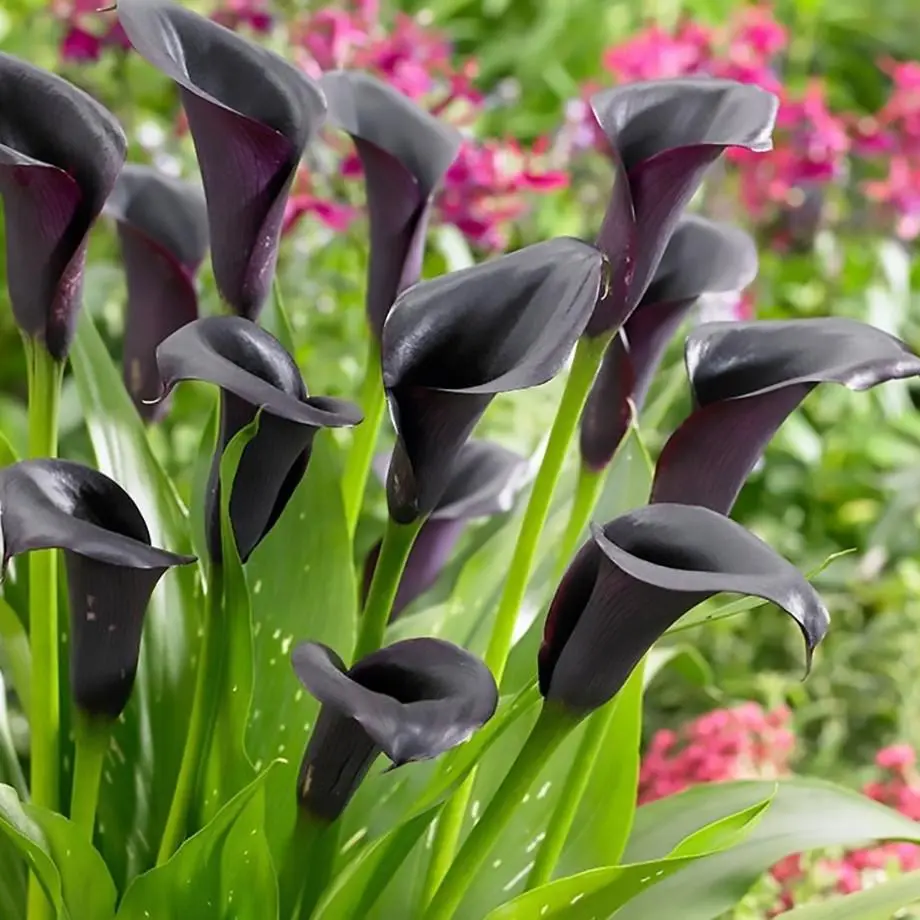
The allure of “black” flowers reaches the world of calla lilies as well! While there isn’t a true black calla lily variety, there are some cultivars that boast incredibly deep, velvety blooms that appear almost black in certain lighting conditions. These calla lilies are a favorite among gardeners for their dramatic and elegant look.
Shades of Deepest Purple:
- Black Star Calla Lily: This popular variety features near-black, deep burgundy blooms with a subtle sheen. The contrasting dark green foliage with white speckles adds to the dramatic effect.
- Odessa Calla Lily: This calla lily boasts striking, dark, eggplant-colored flowers that appear almost black in low light. It’s a stunning choice for borders, containers, or cut flower arrangements.
Not Quite Black, But Breathtaking Nonetheless:
It’s important to note that these “black” calla lilies are not truly black. They are a very deep shade of purple that appears black depending on the lighting. But that doesn’t diminish their beauty! These deep, rich colors add a touch of sophistication and mystery to any garden.
Growing Tips for Black Calla Lilies:
Calla lilies, including the “black” varieties, are known for their elegance and relative ease of care. Here’s a quick guide:
- Planting: Plant calla lily bulbs in spring after the danger of frost has passed.
- Light: Calla lilies prefer full sun to partial shade.
- Soil: Plant them in well-drained, fertile soil amended with organic matter.
- Watering: Water regularly during the growing season, keeping the soil consistently moist but not soggy.
- Winter Care: In colder climates, calla lilies may not survive harsh winters outdoors. You can dig up the bulbs in fall and store them indoors over winter, or treat them as annuals and plant new bulbs each spring.


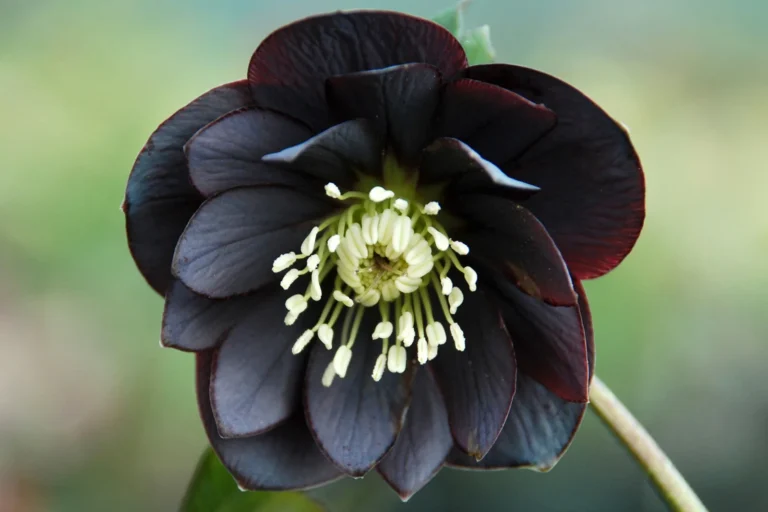
0 Comments